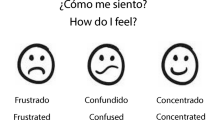Abstract
We conducted a user study that explored the relationship between students’ usage of multiple external representations and their affective states during fractions learning. We use the affective states of the student as a proxy indicator for the ease of reasoning with the representation. Extending existing literature that highlights the advantages of learning with multiple external representations, our results indicate that low-performing students have difficulties in reasoning with representations that do not fully accommodate the fraction as a part-whole concept. In contrast, high-performing students were at ease with a range of representations, including the ones that vaguely involved the fraction as part-whole concept.
Access this chapter
Tax calculation will be finalised at checkout
Purchases are for personal use only
Similar content being viewed by others
References
Bazaldua, D.L., de Baker, R.S.J., Pedro, M.O.S.: Comparing expert and metric-based assessments of association rule interestingness. In: Proceedings of EDM (2014)
Cox, R.: Representation interpretation versus representation construction: an ILEbased study using switchERII. In: Proceedings of AIED, pp. 434–441
D’Mello, S.K., Lehman, B., Pekrun, R., Graesser, A.C.: Confusion can be beneficial for learning. Learn. Instr. 29(1), 153–170 (2014)
Grawemeyer, B., Mavrikis, M., Holmes, W., Gutiérrez-Santos, S., Wiedmann, M., Rummel, N.: Affective learning: Improving engagement and enhancing learning with affect-aware feedback. User Model. User-Adap. Inter. - Special Issue on Impact of Learner Modeling (2017)
Hahsler, M., Chelluboina, S.: Visualizing association rules: introduction to the R-extension package arulesViz (2011). R project module
Janning, R., Schatten, C., Schmidt-Thieme, L.: Perceived task-difficulty recognition from log-file information for the use in adaptive intelligent tutoring systems. Int. J. Artif. Intell. Educ. 26(3), 855–876 (2016)
Rau, M.A., Aleven, V., Rummel, N.: Intelligent tutoring systems with multiple representations and self-explanation prompts support learning of fractions. In: Proceedings of AIED, pp. 441–448 (2009)
Stenning, K.: Seeing Reason: Image and Language in Learning to Think. Oxford University Press, Oxford (2002)
Suthers, D.D.: Towards a systematic study of representational guidance for collaborative learning discourse. J. Univ. Comput. Sci. 7(3), 254–277 (2001)
Author information
Authors and Affiliations
Corresponding author
Editor information
Editors and Affiliations
Rights and permissions
Copyright information
© 2017 Springer International Publishing AG
About this paper
Cite this paper
Grawemeyer, B., Mavrikis, M., Mazziotti, C., Hansen, A., van Leeuwen, A., Rummel, N. (2017). Exploring Students’ Affective States During Learning with External Representations. In: André, E., Baker, R., Hu, X., Rodrigo, M., du Boulay, B. (eds) Artificial Intelligence in Education. AIED 2017. Lecture Notes in Computer Science(), vol 10331. Springer, Cham. https://doi.org/10.1007/978-3-319-61425-0_53
Download citation
DOI: https://doi.org/10.1007/978-3-319-61425-0_53
Published:
Publisher Name: Springer, Cham
Print ISBN: 978-3-319-61424-3
Online ISBN: 978-3-319-61425-0
eBook Packages: Computer ScienceComputer Science (R0)




